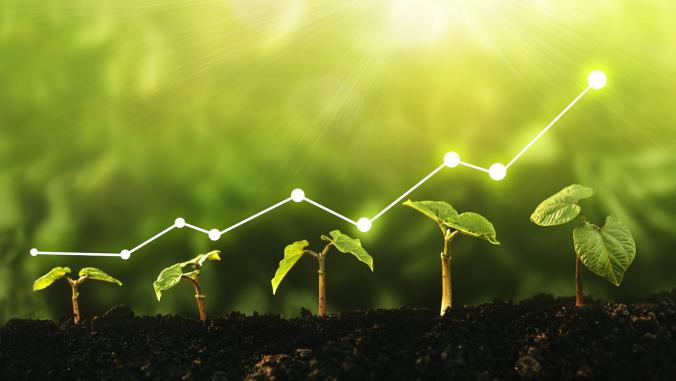Maersk charts course toward sustainable shipping
For now, though, a biofuels-powered vessel is the only type of zero-carbon vessel the industry's global leader is piloting.

Shipping accounts for 90 percent of transported goods and 3 percent of total global CO2-emissions, and is set to rise to 15 percent by 2050 if left unchecked.
In March, global shipping giant Maersk inched closer to meeting its commitment to go carbon neutral by 2050 with a pilot of a biofuels-powered vessel.
Teaming up with Shell and other members of the Dutch Sustainable Growth Coalition, Maersk tested a fuel blend of 20 percent biofuel, produced from waste cooking oil, in one of its largest vessels on an expedition from Rotterdam to Shanghai. Touted as the "world’s first at this scale," Maersk reports that the 25,000-nautical-mile journey will save 1,500 metric tonnes of carbon dioxide emissions.
"Through this pilot, we aim to learn more about using biofuels in general and to understand the possibilities around increasing its usage in a sustainable and economical way," John Kornerup, head of sustainability strategy and climate change at Maersk, said in an email.
The largest shipping company in the world, Maersk is the first to commit to decarbonize in line with the United Nations International Maritime Organization’s carbon reduction goals. In April 2018, the organization reached an agreement calling for a 50 percent reduction in shipping emissions by 2050, based on a 2008 baseline.
Shipping accounts for 90 percent of transported goods and 3 percent of total global CO2 emissions and is set to rise to 15 percent by 2050 if left unchecked. In fact, if shipping were a country it would be the sixth largest emitter.
Achieving carbon neutrality by 2050 will be no small feat, and to reach that goal, Maersk emphasizes the importance of developing zero-carbon vessels, while calling on its peers and value chain partners to meet its ambition.
"The pursuit of solutions must begin now," states Maersk’s 2018 Sustainability Report. "Given the 20 to 25-year lifetime of a vessel, we must have the first zero-carbon and commercially viable vessel on the seas by 2030."Maersk tested a fuel blend of 20 percent biofuel, produced from waste cooking oil, in one of its largest vessels on an expedition from Rotterdam to Shanghai.
Furthermore, "Efficiency gains do not . . . solve the climate change problem. That can only be achieved through decarbonization."
At the moment, a biofuels-powered vessel is the only type of zero-carbon vessel that Maersk is piloting or conducting research on, according to Kornerup. The shipping giant is starting with a 20 percent blend. Powering a ship with 100 percent biofuel could be "problematic" and requires further testing and validation, said Kornerup in an email.
"We are understanding and validating what fuels can be applied to ocean transport, as well as what they require in terms of both commercial/supply chain development and technical development for our vessels and the fuels themselves," he elaborated further. "Biofuels could be a transitional solution or part of the longer-term solution."

To get a better understanding of just what it will take to get zero carbon vessels on the water by 2030, GreenBiz spoke with James Mitchell, maritime finance lead at Rocky Mountain Institute (RMI).
RMI has worked for more than a decade on shipping efficiency and is working now with the Global Maritime Forum, the University College London and others to formulate a climate-related agreement among financial institutions that finance the shipping industry. An announcement related to their work is expected later this year. Following is a lightly edited version of our conversation.
Meg Wilcox: How robust is Maersk’s commitment?
James Mitchell: First, it’s important to understand that due to the expected growth in global trade, there will be more vessels in the water by 2050, and that means that to achieve an overall emissions reduction of 50 percent, each vessel must achieve an 85 percent reduction in carbon by 2050. We think that Maersk has done the math on this, and they’ve realized that given their options for decarbonization — which are changing operations slightly, making them more efficient, making some technical modifications to vessels and using low-carbon fuels — they’re recognized that to get there, they have to go the whole nine yards. That is, they have to do zero-carbon fuels to achieve the 85 percent reduction per vessel.
It’s a very clever play on Maersk’s part to make this commitment now because they recognize that they can’t do this on their own. They will need their competitors to take that same path with them to ensure that the global infrastructure for fueling can be built out and to ensure that there’s a significant enough demand signal for technologies and fuel companies to make the investments that will be needed to power this low-carbon transition.
We commend them, and now we are looking for the specific steps they’ll take to show that they are on this path to achieve carbon neutrality by 2050.
Wilcox: What’s the feasibility of getting zero-carbon vessels on the water by 2030?
Mitchell: The technology exists today for ships to run on batteries, hydrogen and ammonia. While these technologies exist, costs are high so they’re not necessarily ready to be installed today. But as vessels are coming onto the water even today, we need to ensure that they’re being built to be easily retrofitted. Or preferably, no retrofit will be necessary to run these zero-carbon fuels. There are implications for how the fueling infrastructure is designed as well. These are things that shipping companies can be thinking about today.
Essentially, the question boils down to how do we ensure that it happens. There are three factors or barriers to consider.
Wilcox: What are the barriers?
Mitchell: First is infrastructure, the chicken-and-egg problem. If you run a ship on ammonia or hydrogen, you need the fueling infrastructure globally to run that ship or, or at a minimum on a specific trade lane that a ship will operate on for a number of years. It’s all well and good to have one hydrogen fueling station if you’re in, say, New York, but if you’re going to run a shipping company, that infrastructure has to expand to become global.
Second, costs. The additional cost to decarbonize for shipping could run $150 to $350 per tonne of CO2, largely due to the cost of zero-carbon fuels. Given that, how can we bring this cost down? How can shipping companies come together to guarantee a certain level of demand, by a certain year, to guarantee investment to develop that infrastructure and technologies? As with previous shipping environmental transitions — for ballast water and the installation of scrubbers — the cheaper the transition, the easier it will be. The shipping industry is decentralized, with lots of smaller shipowners with less access to capital. So anytime you create a requirement for significant capital investment, that is a huge hurdle for much of the industry.
Third is policy. Carbon is clearly an externality that needs to be addressed. It’s widely known that zero-carbon fuels are necessary to decarbonize the shipping industry, so therefore we should design policies to address this clear barrier.
There will be more vessels in the water by 2050, and that means that to achieve an overall emissions reduction of 50 percent, each vessel must achieve an 85 percent reduction in carbon by 2050.
Wilcox: What are the most promising zero-emission vessels?
Mitchell: There are not a lot of options. The best available research suggests that for deep sea shipping, intercontinental shipping, the best available fuel is ammonia. Hydrogen and batteries are more likely for short sea shipping, such as around Europe. Do batteries and fuel cells exist? Yes. Biofuels may play a small role in shipping’s decarbonization. It’s more the case of, are they trusted? Are they ready to be deployed at scale? Are the costs rights? And the answer at present to some of those is no. It’s a chicken-and-egg situation with several factors needing to come into line for the deployment of these new technologies to occur. The "Mission Possible Report" by the Energy Transitions Commission is a good resource.
Wilcox: What’s your view on biofuels as a solution for shipping?
Mitchell: Biofuels are a small piece of the puzzle for long-term decarbonization, or perhaps a bridge fuel to keep shipping emissions aligned with this science-based pathway to 2050. Such huge volumes are needed for the shipping industry, that I think more questions need to be asked about the viability of running the entire global fleet on biofuels. In addition, there are other industries that will need to compete with bio-feedstocks, such as aviation. We need to be thinking strategically about the global economy and how the sectors will contribute to decarbonization. Biofuels are not the answer, but they may help in the short to medium term.
They are also something you can do alone, while you wait for your peers to act. Other fuels are not the same; they require new infrastructure. We are very interested to see what Maersk does beyond biofuels.
Wilcox: Is fuel efficiency still important for shipping?
Mitchell: On the one hand, it’s not the solution. It’s not going to get us to decarbonization but, on the other hand, because of the high costs of zero-carbon fuel, anything that can be done on energy efficiency today and into the future is going to make the cost increase for zero-carbon fuels smaller for a shipping company. Energy efficiency remains incredibly important and the development of technologies that create savings should continue at pace.
Examples of energy efficiency technologies that are extremely new and still in the nascent stages of being rolled out include "flettner" rotors. These are mechanical sails, big spinning columns that capture wind in a certain way and reduces fuel consumption. A company called Norsepower is leading the installation of these flettner rotors. Another one is a company called Silver Stream. They have an air lubrication system that drills a series of holes in an optimized shape on the bottom of the vessel. It pumps very small bubbles into the hull of the vessel that reduce friction and therefore reduce fuel consumption.





